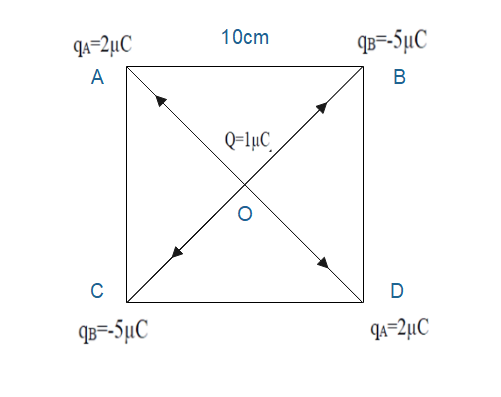
Four point charges ${{q}_{A}}=2\mu C,$ ${{q}_{B}}=-5\mu C,$ ${{q}_{C}}=2\mu C,$ ${{q}_{D}}=-5\mu C,$ are located at the corners of a square ABCD of side 10cm. What is the force on charge of $1\mu C,$ placed at the center of the square?
Answer
556.5k+ views
Hint: State the Coulomb’s law and hence write the expression for the force of attraction or repulsion between two charges. Find the magnitude and direction of each force acting on charge Q due to charges at the corners of the square ABCD. Add or compare the forces acting on Q. Conclude resultant of forces of equal magnitude and acting in opposite directions is zero.
Complete answer:

Let assume point charges ${{q}_{A}}=2\mu C,$${{q}_{B}}=-5\mu C,$${{q}_{C}}=2\mu C,$${{q}_{D}}=-5\mu C,$be located at corners A, B, C, and D of square ABCD respectively. Let $\text{Q}=1\mu C,$be at center O of the square.
The force between two point charges ${{q}_{1}}$and ${{q}_{2}}$distance r apart is given by coulomb’s law which states that the force of attraction or repulsion between two point charges is directly proportional to the product of their charges and inversely proportional two the square of the distance between them. Thus,
$\begin{align}
& F\propto \dfrac{{{q}_{1}}{{q}_{2}}}{{{r}^{2}}} \\
& F=K\dfrac{{{q}_{1}}{{q}_{2}}}{{{r}^{2}}} \\
\end{align}$
Where K is the constant of proportionality.
In vector form, Coulomb’s law can be written as
$\vec{F}=K\dfrac{{{q}_{1}}{{q}_{2}}}{{{r}^{2}}}\hat{r}$
Thus, the force acting on charge Q due to charge ${{q}_{A}}$is
${{F}_{A}}=K\dfrac{Q{{q}_{A}}}{AO}$
Force acting on charge Q due to charge ${{q}_{B}}$is
${{F}_{B}}=K\dfrac{Q{{q}_{B}}}{BO}$
Force acting on charge Q due to charge ${{q}_{C}}$is
${{F}_{C}}=K\dfrac{Q{{q}_{C}}}{CO}$
Force acting on charge Q due to charge ${{q}_{D}}$is
${{F}_{D}}=K\dfrac{Q{{q}_{D}}}{DO}$
We have, ${{q}_{A}}={{q}_{C}}$and AO=CO,
${{F}_{A}}={{F}_{C}}$(in magnitude)
But forces ${{F}_{A}}$and ${{F}_{C}}$ are directed towards O,
${{\overset{\scriptscriptstyle\rightharpoonup}{F}}_{A}}=-{{\overset{\scriptscriptstyle\rightharpoonup}{F}}_{C}}$
Thus, the force acting on charge Q due to charges ${{q}_{A}}$and ${{q}_{C}}$are equal in magnitude but opposite in direction. Therefore they cancel out each other.
Similarly, we have, ${{q}_{B}}={{q}_{D}}$and BO=DO,
${{F}_{B}}={{F}_{D}}$(in magnitude)
But forces ${{F}_{B}}$and ${{F}_{D}}$are directed towards O,
${{\overset{\scriptscriptstyle\rightharpoonup}{F}}_{B}}=-{{\overset{\scriptscriptstyle\rightharpoonup}{F}}_{D}}$
Thus, force acting on charge Q due to charges ${{q}_{B}}$and ${{q}_{D}}$are equal in magnitude but opposite in direction. Therefore they cancel out each other.
Hence, the total force acting on charge Q due to charges at the corners of square ABCD is zero.
Note:
Carefully write Coulomb’s law in magnitude and vector form. Since force is a vector, you have to consider both the magnitude as well as the direction. The forces acting in opposite directions but having equal magnitude contribute to zero. Coulomb’s law is valid for only point charges. If you have a system of two or more point charges then use the principle of superposition to calculate resultant force.
Complete answer:

Let assume point charges ${{q}_{A}}=2\mu C,$${{q}_{B}}=-5\mu C,$${{q}_{C}}=2\mu C,$${{q}_{D}}=-5\mu C,$be located at corners A, B, C, and D of square ABCD respectively. Let $\text{Q}=1\mu C,$be at center O of the square.
The force between two point charges ${{q}_{1}}$and ${{q}_{2}}$distance r apart is given by coulomb’s law which states that the force of attraction or repulsion between two point charges is directly proportional to the product of their charges and inversely proportional two the square of the distance between them. Thus,
$\begin{align}
& F\propto \dfrac{{{q}_{1}}{{q}_{2}}}{{{r}^{2}}} \\
& F=K\dfrac{{{q}_{1}}{{q}_{2}}}{{{r}^{2}}} \\
\end{align}$
Where K is the constant of proportionality.
In vector form, Coulomb’s law can be written as
$\vec{F}=K\dfrac{{{q}_{1}}{{q}_{2}}}{{{r}^{2}}}\hat{r}$
Thus, the force acting on charge Q due to charge ${{q}_{A}}$is
${{F}_{A}}=K\dfrac{Q{{q}_{A}}}{AO}$
Force acting on charge Q due to charge ${{q}_{B}}$is
${{F}_{B}}=K\dfrac{Q{{q}_{B}}}{BO}$
Force acting on charge Q due to charge ${{q}_{C}}$is
${{F}_{C}}=K\dfrac{Q{{q}_{C}}}{CO}$
Force acting on charge Q due to charge ${{q}_{D}}$is
${{F}_{D}}=K\dfrac{Q{{q}_{D}}}{DO}$
We have, ${{q}_{A}}={{q}_{C}}$and AO=CO,
${{F}_{A}}={{F}_{C}}$(in magnitude)
But forces ${{F}_{A}}$and ${{F}_{C}}$ are directed towards O,
${{\overset{\scriptscriptstyle\rightharpoonup}{F}}_{A}}=-{{\overset{\scriptscriptstyle\rightharpoonup}{F}}_{C}}$
Thus, the force acting on charge Q due to charges ${{q}_{A}}$and ${{q}_{C}}$are equal in magnitude but opposite in direction. Therefore they cancel out each other.
Similarly, we have, ${{q}_{B}}={{q}_{D}}$and BO=DO,
${{F}_{B}}={{F}_{D}}$(in magnitude)
But forces ${{F}_{B}}$and ${{F}_{D}}$are directed towards O,
${{\overset{\scriptscriptstyle\rightharpoonup}{F}}_{B}}=-{{\overset{\scriptscriptstyle\rightharpoonup}{F}}_{D}}$
Thus, force acting on charge Q due to charges ${{q}_{B}}$and ${{q}_{D}}$are equal in magnitude but opposite in direction. Therefore they cancel out each other.
Hence, the total force acting on charge Q due to charges at the corners of square ABCD is zero.
Note:
Carefully write Coulomb’s law in magnitude and vector form. Since force is a vector, you have to consider both the magnitude as well as the direction. The forces acting in opposite directions but having equal magnitude contribute to zero. Coulomb’s law is valid for only point charges. If you have a system of two or more point charges then use the principle of superposition to calculate resultant force.
Watch videos on
Four point charges ${{q}_{A}}=2\mu C,$ ${{q}_{B}}=-5\mu C,$ ${{q}_{C}}=2\mu C,$ ${{q}_{D}}=-5\mu C,$ are located at the corners of a square ABCD of side 10cm. What is the force on charge of $1\mu C,$ placed at the center of the square?

Electric Charges and Fields Class 12 Physics - NCERT EXERCISE 1.6 | Physics NCERT | Vishal Kumar Sir
Subscribe
 Share
Share likes
563 Views
2 years ago
Recently Updated Pages
Master Class 12 Economics: Engaging Questions & Answers for Success

Master Class 12 Maths: Engaging Questions & Answers for Success

Master Class 12 Biology: Engaging Questions & Answers for Success

Master Class 12 Physics: Engaging Questions & Answers for Success

Basicity of sulphurous acid and sulphuric acid are

Master Class 12 Business Studies: Engaging Questions & Answers for Success

Trending doubts
How much time does it take to bleed after eating p class 12 biology CBSE

Explain sex determination in humans with line diag class 12 biology CBSE

Differentiate between homogeneous and heterogeneous class 12 chemistry CBSE

When was the first election held in India a 194748 class 12 sst CBSE

Explain sex determination in humans with the help of class 12 biology CBSE

December 10th of 1948 is an important day in the history class 12 sst CBSE



 Watch Video
Watch Video
